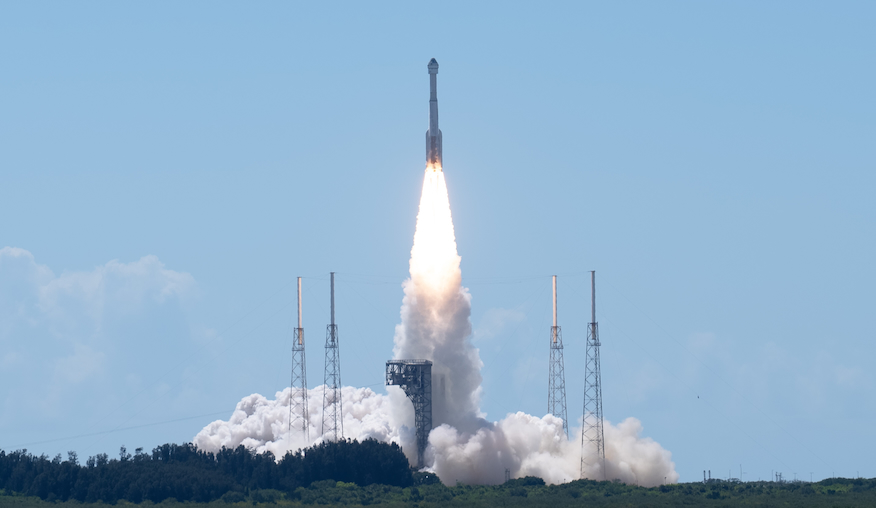News
Third time’s the charm for the Boeing Starliner Crew Flight Test – Spaceflight Now

Replace June 5, 12:06 p.m.: The Boeing Starliner spacecraft efficiently separated from the Centaur higher stage of the Atlas 5 rocket. The spacecraft accomplished its orbital insertion burn and a subsequent burn to circularize its orbit.
The third time was the appeal for the primary crewed flight of Boeing’s Starliner spacecraft. After two launch makes an attempt on Could 6 and June 1 ended with scrubs, the Atlas 5 rocket roared off pad 41 at Cape Canaveral Area Power Station, starting a greater than week-long mission for NASA astronauts Butch Wilmore and Suni Williams.
Liftoff befell on June 5 at 10:52 a.m. EDT (1452 UTC), lastly marking the primary crewed flight of Boeing’s Starliner spacecraft after years of delays and setbacks. The spacecraft efficiently accomplished its orbital insertion burn about 31 minutes into flight after which circularized its orbit with one other burn at T+1 hour and quarter-hour into the mission.
“Two daring NASA astronauts are effectively on their approach on this historic first check flight of a brand-new spacecraft,” mentioned NASA Administrator Invoice Nelson, in an announcement. “Boeing’s Starliner marks a brand new chapter of American exploration. Human spaceflight is a daring activity – however that’s why it’s price doing. It’s an thrilling time for NASA, our industrial companions, and the way forward for exploration. Go Starliner, Go Butch and Suni!”
The Wednesday morning launch got here following the newest scrub brought on by a countdown pc difficulty on the launchpad, which United Launch Alliance was in a position to treatment on Sunday, June 2.
“I actually admire all of the work by the NASA, Boeing, and ULA groups during the last week,” mentioned Steve Stich, supervisor of NASA’s Business Crew Program, in a prelaunch assertion. “Specifically, the ULA group labored actually arduous to rapidly study extra about these points, hold our NASA and Boeing groups knowledgeable, and defend for this subsequent try. We’ll proceed to take it one step at a time.”
Heading into the launch try, the forty fifth Climate Squadron forecast a 90 p.c probability of favorable climate at liftoff with solely cumulus clouds of attainable concern. With a number of the sunspots that prompted the current auroras round globe reemerging this week, meteorologists are additionally maintaining a tally of photo voltaic exercise.
With two good orbital burns behind them, the two-person crew is about to dock with the ISS at about 12:15 p.m. EDT (1615 UTC) on June 6. If all goes effectively with the mission, the crew will return for a touchdown in White Sands, New Mexico on June 14.
The launch on June 5 got here almost a month after the unique launch date of Could 6. That launch was scuttled by an oxygen strain aid valve on the Altas 5 rocket’s higher stage. The mission stood down for weeks as groups assessed a helium leak on the Starliner’s service module.
Popping out of a deliberate maintain at T-minus 4 minutes throughout the second launch try, the countdown reached the T-minus 3 minutes and 50 seconds when one of many three floor launch sequencer circuit boards did not synch with the opposite two, which prompted the scrub.
ULA’s President and CEO Tory Bruno mentioned as a result of the mission confronted an instantaneous launch window, there wasn’t sufficient time to correctly assess the difficulty in actual time to find out if a repair may very well be achieved earlier than liftoff.
“The frustration lasts for about three seconds. And you then simply instantly get busy and do your job,” Bruno mentioned whereas talking with reporters on Saturday following the scrub.

Mark Nappi, Boeing’s Starliner mission supervisor, mentioned there was disappointment from his group as effectively, however that rapidly turned to resilience.
“You understand whenever you’re taking part in a sport and also you get a foul name, you’re just a little irritated at first, or just a little pissed off at first, however you instantly concentrate on the subsequent pitch and that’s what our groups do, they’re targeted on the subsequent pitch,” Nappi mentioned. “As quickly as we went into the launch scrub and launch turnaround, I appeared out into the management room and all people had their heads down, working the procedures to prepare for an additional try.”
The Crew Flight Check of Starliner comes greater than 4 years from SpaceX launching its first astronaut missions utilizing its Crew Dragon spacecraft. Each firms gained multi-billion greenback contracts from NASA to offer transporter for its astronauts as a part of the Business Crew Program.
After the lunch of the Demo-2 mission, SpaceX went on to ship greater than 50 individuals to house over the course of 13 flights, 12 of which went to the ISS. Boeing is working to beat a years-long delay on account of quite a few technical points that value the corporate greater than $1 billion.
As soon as the CFT mission wraps up, Boeing will work with NASA to complete certifying Starliner for full crew rotation missions, which might start as quickly because the spring of 2025.
-

 News2 weeks ago
News2 weeks agoRep. Bennie Thompson fires staffer after controversial posts over Trump attack
-

 News4 weeks ago
News4 weeks ago‘The God of the Woods,’ by Liz Moore book review
-

 News4 weeks ago
News4 weeks agoThe current GC standings at the Tour de France 2024
-

 News4 weeks ago
News4 weeks agoMexico vs. Venezuela prediction, odds, start time: 2024 Copa America picks, June 26 bets by soccer expert
-

 News4 weeks ago
News4 weeks agoRussell wins Austrian Grand Prix after late Verstappen-Norris collision | Motorsports News
-

 News2 weeks ago
News2 weeks agoDuck Donuts brings back Shark Dozen deal during Shark Week
-

 News4 weeks ago
News4 weeks agoRep. Thomas Massie shares about wife Rhonda’s death
-

 News4 weeks ago
News4 weeks agoKamala Harris acknowledges Biden had a ‘slow start’ in debate – NBC4 Washington
